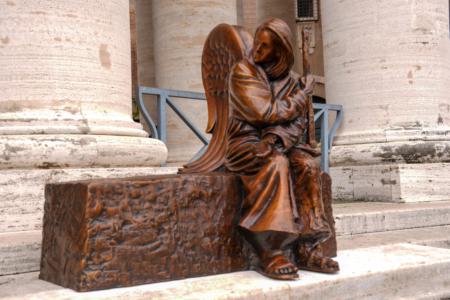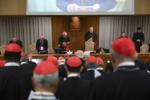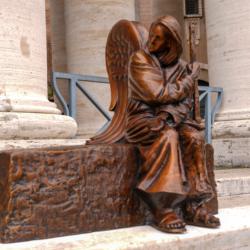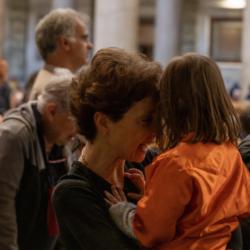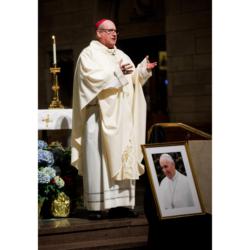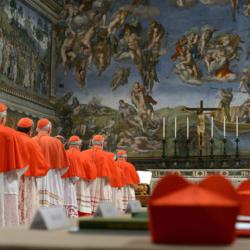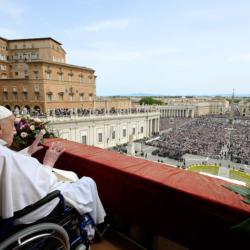Pastors, staff learn reconfiguration details
BRIGHTON — Dozens of pastors and parish staff in the Central Region of the Archdiocese of Boston met at St. John’s Seminary March 30 to learn what closing a parish and welcoming parishioners from a closed parish will entail. Similar orientations have been held in every region in the archdiocese.
Kathleen Heck, special assistant to the moderator of the curia for reconfiguration, began the meeting by telling pastors and their staff of the importance of being prepared for the tasks and responsibilities that lie ahead.
"Whether your parish will be designated for closing or welcoming does not matter," Heck told them. "This process will affect 357 parishes, and it is important for all of us to hear everything."
Heck recognized the deep emotions attached to closing a parish and assured priests and staff that if their parish does close, it will be through no fault of their own. “Do not let yourself think that it was anything you did or failed to do that brought this on,” she said.
Among the topics covered during the meeting were severance pay for displaced employees, financial considerations associated with closing a parish, facilities issues related to churches, the actual closing process and parish volunteers.
During the three hour session, Marnee Walsh, director of human resources for the archdiocese, explained the severance package any terminated employees would receive. She stressed that all employees who lose their jobs because of reconfiguration, not simply those in closed parishes, will receive unemployment benefits.
Because, as a religious organization, the Archdiocese of Boston does not participate in the state unemployment program, a comparable policy for workers was developed less than 10 years ago when the archdiocese experienced a smaller-scaled reconfiguration.
The archdiocese will also provide access to health care and will assist former employees in finding new jobs through the establishment of a career resources center.
Denise McKinnon-Biernat, director of the Office for Financial Planning, told attendees that a manual detailing the process of closing a parish is currently being organized and will be delivered to parishes the day the closures are announced. She briefly explained some of the financial aspects involved, such as the closing of bank and credit card accounts, termination of service agreements, cancellation of leases on parish office equipment, the creation of an inventory of financial records and issuance of tax forms to former employees.
Next Peter Silva, archdiocesan director of facilities, told attendees that his staff will meet with a representative of a church announced for closure in order to glean information about the building from them. His office will need to know among other things: the church’s alarm system and locks, maintenance records, the history of the stained glass windows and whether the church is located in an area prone to vandalism.
Heck emphasized to pastors and their staff that they will not go through the closing process alone. “The number one message you will receive today is that you will have a lot of support if you are designated for closing,” she assured.
Heck will visit every parish designated for closing and for welcoming parishioners of a closed parish. Parishes will learn the effective date of the parish closure on the day the announcement of parish closings is made, she said. The effective date can range from eight weeks up until four months from when the closings are announced.
During her visits to parishes, she will ask pastors to identify five people who will serve on a transition team for approximately one year, to help close the parish and welcome parishioners to their new parish. One person between the ages of 15 through 25, 25 through 40, 40 through 55, 55 through 70 and over the age of 70 years old will be needed on a parish’s transition team, Heck said.
She said that the transition teams, along with teams comprised of representatives from the various archdiocesan offices involved such as human resources, finance and facilities and temporary employees hired for reconfiguration, are being established to assist the priests and their staff. This support is designed to free priests for “the most important responsibility of all, which is the hearts and souls of those people,” Heck said.
Heck then discussed a number of frequently asked questions she has received from priests and parishioners about sacred objects, weddings, stained glass windows, church organs and parish cemeteries.
In the case of sacred objects, Heck said they can either go to the welcoming parish, go to another parish or location within the archdiocese or be sent to a parish outside of the archdiocese. For example, Heck said that a priest from a poor parish in Texas has requested a crucifix that can be placed over the altar in his church.
Stained glass windows that can be easily extracted can be installed or mounted and displayed at another parish. They also may be intentionally destroyed if they could not be extracted without shattering.
Heck advised brides that if their parish closes, they will be assisted in finding a nearby location for their wedding, preferably at the welcoming parish. The ceremony could also be held at a parish in the cluster or at a parish in close proximity to the reception site.
Despite the immense task ahead, Heck encouraged pastors and priests to make prayer a priority above all other responsibilities.
"Prayer is where we are going to have to start," she said.
[Editor’s note: Further information on the parish reconfiguration process is available on the archdiocesan website: http://www.rcab.org/Parish_Reconfiguration/HomePage.html]
